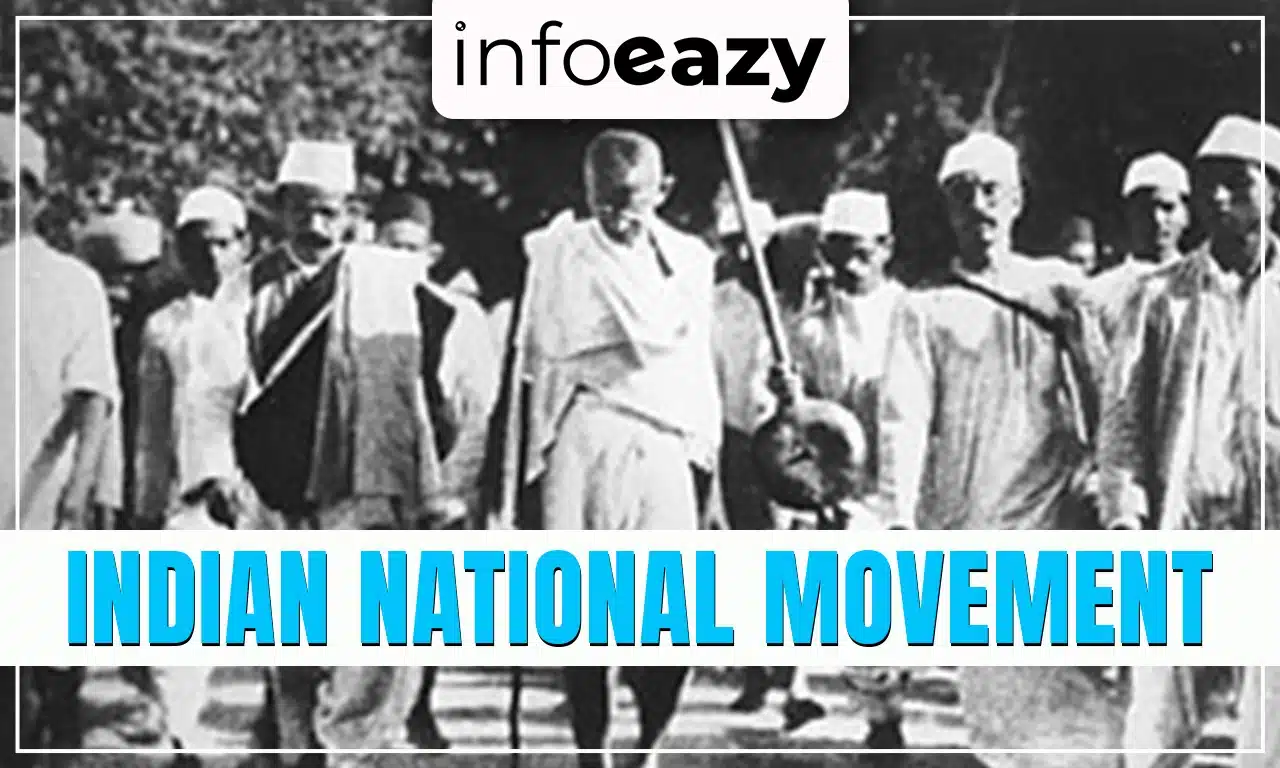The Indian National Movement is one of the most remarkable chapters in India’s modern history. It represents the long struggle of the Indian people against British colonial rule and their collective effort to achieve independence. Spanning from the mid-19th century to 1947, the movement unified diverse communities under one national identity and vision, the quest for Swaraj, or self-rule.
Indian National Movement Background
Before the rise of a nationwide movement, India’s resistance to colonial rule was fragmented and regional. Revolts like the Revolt of 1857 reflected discontent but lacked a unifying ideology. Over time, exposure to Western education, political reforms, and economic exploitation under the British fueled the emergence of a national consciousness.
The introduction of English education, modern communication, and the rise of a new educated middle class helped Indians realize the need for collective action. This period marked the birth of organized nationalism in India.
Growth of National Consciousness in India
The late 19th century saw the rise of awareness about British economic exploitation and political injustice. Reformers, writers, and early nationalists like Raja Ram Mohan Roy, Dadabhai Naoroji, and Gopal Krishna Gokhale inspired Indians to question colonial rule. Newspapers, journals, and social reform movements also played a crucial role in uniting people under the idea of a free India.
This growing sense of unity transformed isolated acts of resistance into an organized national movement demanding political rights and freedom.
Phases of the Indian National Movement
The Indian National Movement evolved over more than six decades, from petitions and debates to mass protests and armed revolts. Between 1885 and 1947, the freedom struggle passed through three main phases: Moderate, Extremist, and Gandhian, each with distinct leadership, ideology, and methods.
This gradual transformation turned a small political organization into a massive national movement that united millions of Indians under one flag for independence.
| Phases of the Indian National Movement | |||||
| Phase | Period | Nature of Struggle | Key Leaders | Major Movements | Outcome |
| Moderate Phase | 1885-1905 | Constitutional and peaceful | Dadabhai Naoroji, G.K. Gokhale, W.C. Bonnerjee | Founding of INC, Petitions, Reforms | Political awakening and foundation of nationalism |
| Extremist Phase | 1905-1919 | Assertive and radical | Bal Gangadhar Tilak, Lala Lajpat Rai, Bipin Chandra Pal | Swadeshi Movement, Boycott of foreign goods | Spread of nationalism among masses |
| Gandhian Phase | 1919-1947 | Mass movements based on non-violence and Satyagraha | Mahatma Gandhi, Jawaharlal Nehru, Sardar Patel, Subhas Chandra Bose | Non-Cooperation, Civil Disobedience, Quit India | India’s Independence (1947) |
Moderate Phase (188-1905)
The Moderate Phase marked the foundation of the Indian National Congress (INC) and the beginning of organized political struggle against British rule. Moderates believed in achieving reforms through constitutional and peaceful means, relying on petitions, debates, and appeals to British justice.
Features
- Belief in gradual reform and cooperation with the British government.
- Emphasis on spreading political awareness among the educated classes.
- Demand for greater Indian representation in administration and legislature.
- Promotion of unity among Indians irrespective of caste or religion.
Prominent Leaders
- Dadabhai Naoroji – Known as the “Grand Old Man of India,” he exposed economic exploitation through his Drain of Wealth Theory.
- Gopal Krishna Gokhale – Advocated moderate reform and education-based progress.
- W.C. Bonnerjee and Surendranath Banerjee – Early Congress leaders promoting national unity.
Major Contributions
- Establishment of the Indian National Congress in 1885.
- Creation of a political platform for Indians to express grievances.
- Spread of early nationalism through press, associations, and meetings.
Outcome
Though the Moderates failed to secure major reforms, they laid the ideological foundation for future phases of the freedom movement.
Extremist Phase (1905-1919)
The Extremist Phase began as a reaction to the Partition of Bengal in 1905, which the British justified as an administrative measure but was widely seen as an attempt to divide Hindus and Muslims. This led to mass protests, boycotts, and the Swadeshi Movement, marking a shift toward assertive nationalism.
Features
- Rejection of faith in British justice and constitutional reforms.
- Demand for Swaraj (Self-Rule) as a birthright.
- Promotion of Swadeshi (use of Indian goods) and Boycott of British goods.
- Use of public meetings, strikes, and nationalist education to spread awareness.
Prominent Leaders
- Bal Gangadhar Tilak – Pioneer of assertive nationalism; his slogan, “Swaraj is my birthright and I shall have it,” inspired millions.
- Lala Lajpat Rai – Known as the “Punjab Kesari,” he fought against repressive British policies.
- Bipin Chandra Pal – Prominent leader from Bengal, emphasized radical methods of protest.
Major Movements
- Swadeshi Movement (1905): Encouraged the boycott of foreign goods and promotion of Indian industries.
- Boycott Movement: Refusal to use British-made goods and institutions.
- Formation of Revolutionary Groups: Secret societies like Anushilan Samiti emerged in Bengal.
Outcome
The Extremist Phase mobilized the masses and gave the freedom struggle a more aggressive and self-reliant direction. However, the movement slowed down after the Split of Congress in 1907 and repression by the British during World War I.
Gandhian Phase (1919-1947)
The Gandhian Phase is considered the golden era of the Indian National Movement. Under Mahatma Gandhi’s leadership, the struggle became a mass movement involving farmers, workers, women, and students. Gandhi’s principles of non-violence (Ahimsa) and truth (Satyagraha) gave the movement a moral and spiritual strength.
Features
- Use of non-violent resistance and civil disobedience.
- Involvement of all sections of society, including peasants and women.
- Promotion of Khadi, village industries, and rural self-reliance.
- Focus on unity, equality, and social reform alongside political freedom.
Major Movements and Campaigns
- Rowlatt Satyagraha (1919): Protest against repressive Rowlatt Acts.
- Non-Cooperation Movement (1920–22): Boycott of British institutions; withdrawal from schools, offices, and legislatures.
- Civil Disobedience Movement (1930–34): Defiance of British laws; Gandhi’s Salt March symbolized resistance.
- Quit India Movement (1942): Final call for British withdrawal; “Do or Die” became the rallying cry.
Prominent Leaders
- Mahatma Gandhi – The guiding spirit of non-violent resistance.
- Jawaharlal Nehru – Advocated industrial progress and socialism.
- Sardar Vallabhbhai Patel – Organizer of civil disobedience and integration efforts.
- Subhas Chandra Bose – Formed the Indian National Army (INA) to fight British rule militarily.
Outcome
The Gandhian Phase transformed the freedom struggle into a people’s movement. Despite imprisonment and suppression, it unified Indians in an unprecedented way and ultimately led to India’s independence in 1947.
Causes Behind the Rise of the Indian National Movement
Several socio-economic and political factors contributed to the rise of nationalism in India:
- Economic Exploitation: British policies destroyed Indian industries and drained wealth to Britain.
- Social and Religious Reform Movements: Reformers like Raja Ram Mohan Roy and Swami Vivekananda inspired unity and awareness.
- Western Education: Spread of liberal ideas such as liberty, equality, and democracy.
- Indian Press: Newspapers and journals spread nationalist ideas widely.
- Global Influences: Revolutions in America, France, and Ireland inspired Indian nationalists.
Major Centers of the Freedom Struggle
The Indian National Movement spread across the subcontinent, with several key centers of activity:
- Bombay (Mumbai): Birthplace of the Indian National Congress and home to major leaders like Tilak and Gandhi.
- Calcutta (Kolkata): Center of revolutionary nationalism and the Swadeshi Movement.
- Ahmedabad: Gandhi’s Sabarmati Ashram and center of early Satyagraha movements.
- Lahore: Site of the 1929 Declaration of Purna Swaraj (complete independence).
- Amritsar: The tragic Jallianwala Bagh Massacre (1919) galvanized national unity.
Impact and Significance of the Indian National Movement
The Indian National Movement was not just a political campaign but a complete transformation of Indian society. It awakened the spirit of unity, equality, and democracy among the people.
The struggle ended colonial rule in 1947 and laid the foundation for the world’s largest democracy. It also influenced global freedom movements and civil rights struggles through Gandhi’s philosophy of non-violence.
Indian National Movement FAQs
Q1. What is the Indian National Movement?+
Q2. Who were the main leaders of the movement?+
Q3. What were the major phases of the movement?+
Q4. When did India achieve independence?+
Tags: Indian National Movement




